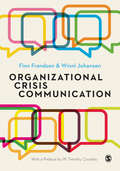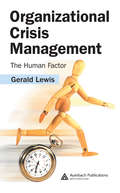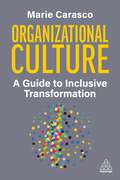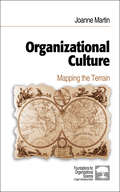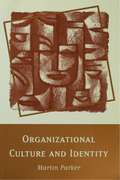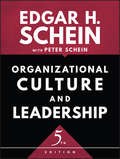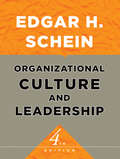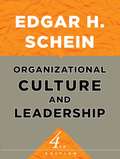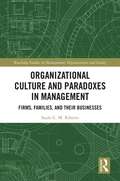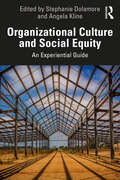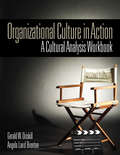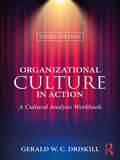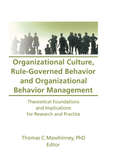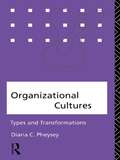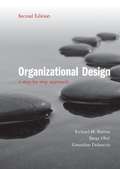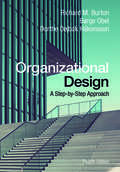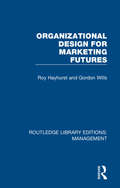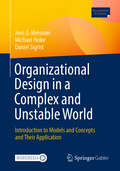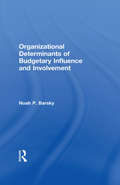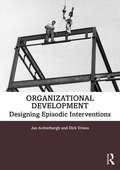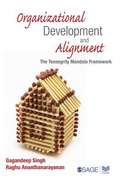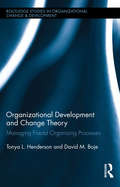- Table View
- List View
Organizational Crisis Communication: A Multivocal Approach
by Professor Finn Frandsen Professor Winni JohansenLecturers/Instructors - Request a free digital inspection copy here When a crisis breaks out, it’s not always just the organization that reacts - the news media, customers, employees, trade associations, politicians, activist groups, and PR experts may also respond. This book offers a new and original perspective on crisis communication based on the theory of the Rhetorical Arena and the so-called multivocal approach. According to this approach, we gain a more dynamic and complex understanding of organizational crises if we focus not only on the communication produced by the organization but also take into account the many other voices who start communicating when a crisis breaks out. It provides: An in-depth overview of the five key dimensions of organizational crises, crisis management and crisis communication A comprehensive introduction to the theory of the Rhetorical Arena and the multivocal approach to crisis communication, including some of the most important voices inside the arena A series of important international case studies and case examples in each chapter. Suitable for students studying crisis communication modules on corporate communication, public relations, and management and organization studies courses.
Organizational Crisis Communication: A Multivocal Approach
by Professor Winni Johansen Professor Finn FrandsenWhen a crisis breaks out, it's not always just the organization that reacts - the news media, customers, employees, trade associations, politicians, activist groups, and PR experts may also respond. This book offers a new and original perspective on crisis communication based on the theory of the Rhetorical Arena and the so-called multivocal approach. According to this approach, we gain a more dynamic and complex understanding of organizational crises if we focus not only on the communication produced by the organization but also take into account the many other voices who start communicating when a crisis breaks out. It provides: An in-depth overview of the five key dimensions of organizational crises, crisis management and crisis communication A comprehensive introduction to the theory of the Rhetorical Arena and the multivocal approach to crisis communication, including some of the most important voices inside the arena A series of important international case studies and case examples in each chapter. Suitable for students studying crisis communication modules on corporate communication, public relations, and management and organization studies courses.
Organizational Crisis Management: The Human Factor
by Gerald LewisOrganizational Crisis Management: The Human Factor offers theoretical background and practical strategies for responding to workplace crises. Responding to a paradigm that focuses on the operational aspects of continuity to the detriment of human factors, this volume provides a comprehensive understanding of the unavoidable yet often complex reacti
Organizational Culture: A Guide to Inclusive Transformation
by Marie CarascoDiscover how to transform company culture by embracing the interconnectedness of business and social interests to promote an inclusive workplace.Organizational Culture offers a comprehensive roadmap for transforming company culture. Using a strategic framework for navigating change, this essential guide provides business leaders and change catalysts with a holistic strategy for building a dynamic and inclusive culture. It highlights the importance of leveraging psychological principles, interpersonal dynamics, employee interest-driven initiatives and cooperative leadership to create lasting change. Featuring case studies for practical insight into how to cultivate trust and employee engagement, Organizational Culture highlights how these steps can help align Diversity, Equity, Inclusion and Belonging (DEIB) initiatives to support culture transformation. The resulting resource breaks down the best ways organizations can start engaging in inclusive culture change.
Organizational Culture: Mapping the Terrain (Foundations for Organizational Science)
by Joanne MartinExpert author Joanne Martin examines a variety of conflicting ways to study cultures in organizations, including different theoretical orientations, political ideologies (managerial, critical, and apparently neutral); methods (qualitative, quantitative, and hybrid approaches), and styles of writing about culture (ranging from traditional to postmodern and experimental). In addition, she offers a guide for those who might want to study culture themselves, addressing such issues as: What qualitative, quantitative, and hybrid methods can be used to study culture? What standards are used when reviewers evaluate these various types of research? What innovative ways of writing about culture have been introduced? And finally, what are the most important unanswered questions for future organizational culture researchers?
Organizational Culture and Identity: Unity and Division at Work
by Martin ParkerOrganizational Culture and Identity discusses the literature concerned with culture in organizations and explains why the term has been invoked with such enthusiasm. Martin Parker presents further ways of thinking about organizations and culture which suggest that organizational cultures should be seen as `fragmented unities' in which members identify themselves as collective at some times and divided at others.
Organizational Culture and Leadership
by Edgar H. Schein Peter ScheinThe book that defined the field, updated and expanded for today's organizations Organizational Culture and Leadership is the classic reference for managers and students seeking a deeper understanding of the inter-relationship of organizational culture dynamics and leadership. Author Edgar Schein is the 'father' of organizational culture, world-renowned for his expertise and research in the field; in this book, he analyzes and illustrates through cases the abstract concept of culture and shows its importance to the management of organizational change. This new fifth edition shows how culture has become a popular concept leading to a wide variety of research and implementation by various organizations and expands the focus on the role of national cultures in influencing culture dynamics, including some practical concepts for how to deal with international differences. Special emphasis is given to how the role of leadership varies with the age of the organization from founding, through mid-life to old age as the cultural issues vary at each stage. How culture change is managed at each stage and in different types of organizations is emphasized as a central concern of leader behavior.. This landmark book is considered the defining resource in the field. Drawing on a wide range of research, this fifth edition contains 25 percent new and revised material to provide the most relevant new concepts and perspectives alongside the basic culture model that has helped to define the field. Dig into assumptions and typologies to decipher organizational culture Learn how culture begins, thrives, or dies with leadership Manage cultural change effectively and appropriately Understand the leader's role in managing disparate groups The resurgence of interest in organizational culture has spurred an awakening in research, and new information is continuously coming to light. Outdated practices are being replaced by more effective methods, and the resulting shift affects organizations everywhere. Organizational Culture and Leadership is an essential resource for scholars, consultants and leaders seeking continuous improvement in the face of today's business realities.
Organizational Culture and Leadership
by Schein Edgar H.Regarded as one of the most influential management books of all time, this fourth edition of Leadership and Organizational Culture transforms the abstract concept of culture into a tool that can be used to better shape the dynamics of organization and change. This updated edition focuses on today's business realities. Edgar Schein draws on a wide range of contemporary research to redefine culture and demonstrate the crucial role leaders play in successfully applying the principles of culture to achieve their organizational goals.
Organizational Culture and Leadership (4th edition)
by Edgar H. ScheinThis updated Fourth Edition management book focuses on today's business realities. Edgar Schein draws on a wide range of contemporary research to redefine culture and demonstrate the crucial role leaders play in successfully applying the principles of culture to achieve their organizational goals.
Organizational Culture and Paradoxes in Management: Firms, Families, and Their Businesses (Routledge Studies in Management, Organizations and Society)
by Saulo C. RibeiroStudies on culture, change and social processes within organizations have been historically organized around orthogonal approaches. While the literature on change has focused on creating pragmatic, generally simple methodologies that bypass the complexity of the data in order to emphasize the possibility of intervention, literature aimed at truly understanding of the firm and its processes has emphasized the ambiguity of organization and the difficulties involved in reaching a unitary view of its processes, let alone creating a single theory of change. Finally, the literature on family businesses has been restricted to limited views of the field, disregarding the rich insights brought by psychology, sociology or anthropology. The result of these trends has been a gap in the creation of knowledge, with a paucity of studies that link theory with practice and ground change on a comprehensive view of the social reality of the firm. This book addresses both the specific need of family businesses and the broader demands of any organization in which the issue of culture is seriously considered. Drawing on the notions and scholarship on organizations and sociology, the author proposes new concepts and tools for the change agents interested in working with the instrumental rules of the firm with the cohesive tone of the family. Organizational Culture and Paradoxes in Management will be of value to students at an advanced level, academics and reflective practitioners. It addresses the topics with regard to management and organizational studies and will be of interest to organizational scholars, consultants and leaders interested in fostering a meaningful culture within organizations and family businesses.
Organizational Culture and Social Equity: An Experiential Guide
by Stephanie Dolamore and Angela KlineSocial equity, or the lack of social equity, is practiced in all of our organizations. By focusing on advancing social equity in organizational culture, public and non-profit organizations can create more inclusive operations, correct historical injustices, and fulfill their mission to serve the community. Social equity is often explored as a grand theory, but it is critical for organizations to identify and practice strategies to apply theory into action. Organizational Culture and Social Equity: An Experiential Guide is the first book of its kind to provide the public service-minded reader with an opportunity to practice social equity. The chapters are designed to be both theoretical and practical, helping the reader develop knowledge to analyze social equity efforts in their own organization as well as the tools to act. The contributing chapter authors in this book explore social equity through various dimensions of organizational culture: physical characteristics and general environment; policies, procedures, and structures; socialization; leadership behavior; rewards and recognition; discourse; and learning and performance. Each contributor provides a thorough overview of their respective culture category along with important theories and concepts, definitions, and strategies for practice. The chapter authors then examine social equity in each area of organizational culture through a learning activity, discussion questions, and a call to action. Each chapter further reinforces concepts with a vignette featuring a public administrator who has faced a situation related to that chapter. Organizational Culture and Social Equity is a timely and essential read for all those who wish to study or practice public administration through an equity lens.
Organizational Culture in Action: A Cultural Analysis Workbook
by Dr Gerald W. Driskill Dr Angela Laird BrentonThis book is a practical guide to "reading" the culture of organizations and to understanding the implications of culture for organizational effectiveness. Beginning with an explanation of the theories of organizational culture, the book provides guidance on collecting information, leading students through qualitative research methods of observation, interviewing, and analyzing written texts. Students come away equipped to apply cultural insights to fostering diversity, supporting organizational change, making leadership more dynamic, understanding the link between ethics and culture, and achieving personal growth.
Organizational Culture in Action: A Cultural Analysis Workbook
by Gerald W. DriskillOffering students and practitioners an applied approach to the subject, Organizational Culture in Action (OCA) walks them through a six-step model for analyzing an organization’s culture to provide insight into positive communication practices to improve organizational ethics and effectiveness. The authors review relevant theory while integrating a constitutive approach to studying organizational culture and communication. Practical guides for multiple data collection methods are provided, and the workbook format is full of interactive tools that engage students and reinforce learning. The revised OCA cultural analysis model in this edition provides the below elements. • The revised first step in the model – "articulating the value of cultural analysis" includes connections to public relations and crisis management. • A definition of communication and the analysis process that foregrounds ethics throughout the book is included. • Recent research on organizational moral learning is integrated in the ethics chapter, and throughout the book. • The Communicative Constitutive of Organizations is now foregrounded throughout the book, and reflected in a table capturing variable and metaphor approaches to culture. • The latest applied research is integrated in units on diversity, change, leadership, and effectiveness in relation to positive organizational communication. • Enriched guides on multiple data collection methods now includes surveys. • Cases, examples, and applications relevant to crisis, employee engagement, virtual organizations, conflict management, and public relations are provided. Professionals come away equipped to apply cultural insights to fostering inclusiveness in relation to diversity, supporting organizational change, making leadership more dynamic, understanding the link between ethics and culture, and achieving personal and professional growth.
Organizational Culture, Rule-Governed Behavior and Organizational Behavior Management: Theoretical Foundations and Implications for Research and Practice
by Thomas C MawhinneyOrganizational Culture, Rule-Governed Behavior and Organizational Behavior Management is an introduction to concepts that link organizational behavior management (OBM) with the fields of organizational ecology, cultural anthropology, organizational development, and organizational behavior. This important book can help OBM researchers and managers more precisely analyze complex work environments to develop more comprehensive yet highly focused interventions to improve individual and organizational effectiveness. Organizational Culture, Rule-Governed Behavior and Organizational Behavior Management includes theoretical accounts of rule-governed behavior and cultural practices that expand the OBM’s boundaries to include more comprehensive analyses and intervention designs that can lead to more effective and larger scale interventions.Although OBM researchers have long recognized that the relationships between an organization and its environment are important for survival, they have not made organization-environment relations a primary focus of their interventions. In addition, most descriptions of OBM interventions have not included a precise account of how the components of the interventions bring about ultimate performance changes they produce. With this book, OBM researchers will learn how to identify organizational behavior/performance targets that can be changed and adapted to constantly changing competitive environments to improve an organization’s chances of survival. It also outlines two theories of rule-governed behavior. These theories characterize and explain how rules and their descriptions work to change or maintain effects of delayed rewards on current behavior/performance relationships. In so doing, they fill in the missing links required to achieve more valid and precise analyses of work environments that can be expected to result in more precise and effective OBM interventions.In Organizational Culture, Rule-Governed Behavior and Organizational Behavior Management, OBM researchers will learn how organizational cultural practices, organizational effectiveness, and rule-governed behaviors in organizations interact in complex ways to determine, in part, the adaptability and long-term survival of organizations. Reading this book will help academics, researchers, and practitioners better understand and predict how people in organizations will react to OBM interventions. All OBM managers including high-level managers, members of boards of directors and their consultants who are attempting to develop more effective organizations, will benefit from these discussions of organizational adaptation changing competitive environments. This essential volume presents organizational culture concepts cast in OBM terms that can be understood by all OBM researchers and practitioners and will be useful to anyone interested in organizational development on a large scale. Professors teaching OBM courses will find this presentation of rule-governed behavior an essential ingredient to every course in OBM.
Organizational Cultures: Types and Transformations
by Diana C. PheyseyFirst published in 1993. Routledge is an imprint of Taylor & Francis, an informa company.
Organizational Design
by Burton, Richard M. and Obel, Børge and Håkonsson, Dorthe Døjbak Richard M. Burton Børge Obel Dorthe Døjbak HåkonssonIn today's volatile business environment, it is more important than ever that managers, whether of a global multinational or a small team, should understand the fundamentals of organizational design. Written specifically for executives and executive MBA students, the new edition of this successful book provides a step-by-step 'how to' guide for designing an organization. It features comprehensive coverage of the key aspects of organizational design, including goals, strategy, process, people, coordination, control and incentives. These aspects are explained through the use of a unique series of 2 x 2 graphs that provide an integrated, spatial way to assess and plan organizational design. The new edition features a number of important improvements, including a new framework for understanding leadership and organizational climate, the introduction of the concept of manoeuvrability and a completely new chapter examining joint ventures, mergers, partnerships and strategic alliances.
Organizational Design
by Richard M. Burton Børge Obel Gerardine DesanctisIn today's volatile business environment, organizational design is a serious challenge for any manager, whether of a multinational enterprise or a small team. This book sets out a step-by-step approach to designing an organization. All the key aspects of organizational design are covered, including goals, strategy, structure, process, people, coordination and control, and incentives. The text engages with critical issues affecting organisations, such as globalization, worldwide competition, deregulation and ever-new technologies, and contains many helpful features such as end-of-chapter reviews and unique step-by-step diagrams to orientate the reader in the design process. Diagnostic questions help the reader to determine the changes needed in an organization. The action oriented approach of this text helps the reader to assess and re-design the complex organizations of today, and plan for the information-rich organizations of tomorrow.
Organizational Design: A Step-by-Step Approach (Information And Organization Design Ser. #4)
by Richard M. Burton Børge Obel Dorthe Døjbak HåkonssonNow in its fourth edition, this is the definitive step-by-step 'how to' guide to designing an organization. Building on information processing theory, the book proposes a holistic, multi-contingency model of the organization. This textbook communicates the fundamentals of traditional and new organizational forms, including up-to-date analysis of self-organizing, boss-less, digital, and sustainable organizations. Providing a framework for the practical implementation of organizational design changes, the authors break the process down into seven basic steps: (1) Assessing Goals, (2) Assessing Strategy, (3) Analyzing Structure, (4) Assessing Process and People, (5) Analyzing Coordination, Control and Incentives, (6) Designing the Architecture, and (7) Implementing the Architecture. Each step connects with one of the nine interdependent components of the multi-contingency model, and the authors also provide a logical query process for approaching each of these components. This is an ideal guide for managers or executives interested in assessing their organization and taking steps to redesign it for success, as well as for MBA and executive MBA students looking for an introduction to organizational design.
Organizational Design for Marketing Futures (Routledge Library Editions: Management)
by Roy Hayhurst Gordon WillsThis study, originally published in 1972, presents a critical, in-depth survey of the organization of marketing activity in the United Kingdom. This report of practice in over 500 major British firms provides some enlightening information and allows certain objective bench-marks to be established for practical guidance. By analysing and presenting clearly the dynamics of organization structure, the authors seek to develop an understanding of marketing’s task within the business and its interaction with other aspects of the organization. The result in a catalyst to the realistic and profitable understanding of marketing development.
Organizational Design in a Complex and Unstable World: Introduction to models and concepts and their application
by Jens O. Meissner Michael Heike Daniel SigristOrganizations of all kinds create a sense of purpose and sometimes incomparable performance that individuals cannot achieve alone. This textbook examines the developments and changes that organizations should make in order to be successful in today's complex organizational environment. The authors explain various models and concepts of organizational design, highlight the important role played by agile management and self-organization and reflect on the consequences these concepts have for practical organizational work. The necessary organizational development can only be meaningfully and successfully implemented with consideration of the existing corporate culture and knowledge of the fundamentals of knowledge management, so these are also taught in the textbook. The overarching goal of organizational design is to promote the organization's resilience to crises. After laying the foundations for this, the penultimate chapter is dedicated to the aspect of resilience, followed by an outlook for the future. The didactic structure of the textbook includes learning objectives, practical examples and case studies as well as learning comprehension questions and the opportunity to test your own knowledge with the Springer Nature Flashcards. This textbook has been recommended and developed for university courses in Germany, Austria and Switzerland.
Organizational Determinants of Budgetary Influence and Involvement
by Noah P. BarskyDrawing on network theory from the organizational sociology literature, this book examines issues related to which organizational factors determine how employees influence the budgeting process. Data were collected from managers who participate in the budgeting process at a major apparel manufacturer. Social network analysis was employed to measure how the structure of the network of managers affects the budgeting process. The results show that budgetary influence is structurally determined and resides with managers holding central positions in the organizational network. Thus, while formal procedures determine which employees are involved in budgeting activities, only centrally positioned managers actually influence budgetary outcomes.The findings indicate that influence, not involvement, is the key to empowerment in the budgeting process. This research suggests that researchers and practitioners should be aware of an organization's social structure when examining a participative budgeting process. The difference between formal designs and actual influence is indicative of a "rhetoric-reality gap" which can impair the effectiveness of management control systems.
Organizational Development: Designing Episodic Interventions
by Dirk Vriens Jan AchterberghOrganizational Development gives readers an understanding of organizational structures and presents a new and easy-to-understand framework which describes the three dimensions of organizational interventions. Interventions in organization often fail. This has been widely acknowledged: many books exist about the topic and many approaches are proposed to guide organizational interventions – but to no avail – so it remains difficult to design and guide them. This is the first book to (1) provide readers with an understanding of organizational structures and why it is both relevant and difficult to change them, and (2) present a model consisting of three underlying dimensions of interventions. The authors describe how this model can be used to design interventions in organizational structures. Containing practical guidelines to show how interventions can be designed and controlled, this book should be considered essential reading for postgraduate students of organizational development, design, and change, and practitioners carrying out organizational development projects.
Organizational Development and Alignment: The Tensegrity Mandala Framework
by Gagandeep Singh Raghu AnanthanarayananOrganizational Development and Alignment: The Tensegrity Mandala Framework takes a close look at the underlying axioms of Organization Design and Alignment that have not only proliferated rigid structures and oppressive hierarchies, but also have rendered employees worldwide as mere instruments and dehumanized the organizational context. By looking at an organizational system as inherently a Tensegrity structure, an architectural paradigm vitalized by Buckminster Fuller, the book offers the reader insights into the dynamic tensions, role-holding, and dialog possibilities that pervade the modern organization across stakeholders such as investors, customers, employees and the ecology. By containing the organization as a 'Mandala', a dynamic force field with arrays of polarities and counter-pulls that burden the leadership, it explicates the various dilemmas that are contained within, and offers insights into design, policies, culture and role-effectiveness. The Tensegrity Mandala empowers the organization of today towards reflexivity and transformation. It serves as a blueprint for growth, organization development, dialog, and institutionalizing leadership.
Organizational Development and Alignment
by Gagandeep Singh Raghu AnanthanarayananOrganizational Development and Alignment: The Tensegrity Mandala Framework takes a close look at the underlying axioms of Organization Design and Alignment that have not only proliferated rigid structures and oppressive hierarchies, but also have rendered employees worldwide as mere instruments and dehumanized the organizational context. By looking at an organizational system as inherently a Tensegrity structure, an architectural paradigm vitalized by Buckminster Fuller, the book offers the reader insights into the dynamic tensions, role-holding, and dialog possibilities that pervade the modern organization across stakeholders such as investors, customers, employees and the ecology. By containing the organization as a 'Mandala', a dynamic force field with arrays of polarities and counter-pulls that burden the leadership, it explicates the various dilemmas that are contained within, and offers insights into design, policies, culture and role-effectiveness. The Tensegrity Mandala empowers the organization of today towards reflexivity and transformation. It serves as a blueprint for growth, organization development, dialog, and institutionalizing leadership.
Organizational Development and Change Theory: Managing Fractal Organizing Processes (Routledge Studies in Organizational Change & Development)
by David M. Boje Tonya HendersonThis book offers a fresh perspective on organizational development and change theory and practice. Building on their recent work in quantum storytelling theory and complexity theory, Henderson and Boje consider the implications of fractal patterns in human behavior with a view toward ethics in organization development for the modern world. Building on Gilles Deleuze and Felix Guattari’s (1987) ontology of multiple moving and intersecting fractal processes, the authors offer readers an understanding of how managing and organizing can be adapted to cope with the turbulence and complexity of different organizational situations and environments. They advocate a sustainable, co-creative brand of agency and introduce appropriate, simple tools to support organizational development practitioners. This book offers theory and research methods to management and organization scholars, along with praxis advice to practicing managers.
